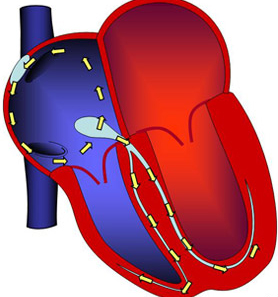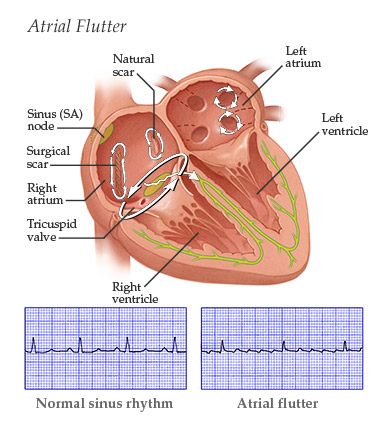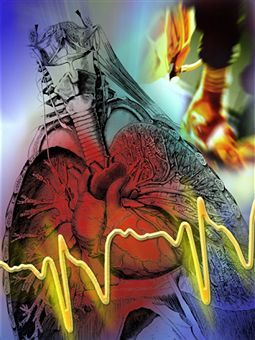Atrial Flutter

Atrial flutter is an abnormal heart rhythm that occurs in the atria of the heart. When it first occurs, it is usually associated with a fast heart rate or tachycardia, and falls into the categoryof supra-ventricular tachycardias. While this rhythm occurs most often in individuals withcardiovascular disease (eg: hypertension, coronary artery disease, and cardiomyopathy), itmay occur spontaneously in people with otherwise normal hearts. It is typically not a stablerhythm, and frequently degenerates into atrial fibrillation. However, in rare cases it doespersist for months to years.
Causes
Arrhythmias are caused by a disruption of the normal functioning of the electrical conductionsystem of the heart. Normally, the atria and ventricles contract in a coordinated manner.In atrial flutter, the atria are stimulated to contract very quickly and differently from the normalactivity originating from the sinoatrial node. This causes the walls of the atria to quiver veryfast (fibrillate) instead of beating normally. As a result, the atria aren’t able to pump blood intothe ventricles the way they should.In atrial flutter the ventricles may beat rapidly, regularly or irregularly. If the atrial flutter is partof a condition called sick sinus syndrome, the sinus node may not work properly, and the heartrate may alternate between slow and fast. The result may be not enough blood to meet theneeds of the body.Atrial flutter can occur for no apparent reason.
Most of the time, however, it is caused by anunderlying condition that damages the heart muscle and its ability to conduct electricalimpulses.Underlying causes of flutter include dysfunction of the sinus node (the "natural pacemaker" ofthe heart) and a number of heart and lung disorders, including coronary artery disease,rheumatic heart disease, mitral valve disorders, pericarditis, and others.Hyperthyroidism, hypertension, and other diseases can cause arrhythmias, as can recentheavy alcohol use (binge drinking). Some cases of atrial flutter occur in the setting of a heartattack or soon after surgery on the heart.

Symptoms of Atrial Flutter
While atrial flutter can sometimes go unnoticed, its onset is often marked by characteristicsensations of regular palpitations. Such sensations usually last until the episode resolves, oruntil the heart rate is controlled.Atrial flutter is usually well tolerated initially (a high heart rate is for most people just a normalresponse to exercise), however, people with other underlying heart disease or poor exercisetolerance may rapidly develop symptoms, which can include shortness of breath, chest pains,lightheadedness or dizziness, nausea and, in some patients, nervousness and feelings ofimpending doom.
Prolonged fast flutter may lead to decompensation with loss of normal heart function (heart failure). This may manifest as effort intolerance (exertional breathlessness), nocturnal breathlessness, or swelling of the legs or abdomen.
Consequences
The two most serious complications of atrial flutter are stroke and heart failure. Stroke can happen when a blood clot travels to an artery in the brain, blocking off blood flow. In atrial flutter, blood clots can form in the atria because some of the blood “pools” in the fluttering atria instead of flowing into the ventricles. If a piece of a blood clot in the left atrium breaks off, it can travel to the brain, causing a stroke. People with atrial flutter are often treated with blood-thinning medicines to reduce the chances of developing blood clots. Heart failure is when the heart can’t pump enough blood to meet the needs of the body. Atrial flutter can cause heart failure when the ventricles beat too fast and don’t have enough time to fill with blood to pump out to the body. Heart failure causes tiredness, leg swelling, and shortness of breath.
Exams and Tests
Listening to the heart with a stethoscope shows fast heart beat. The pulse may feel rapid, irregular, or both. The normal heart rate is 60 to 100, but in flutter the heart rate may be 100 to 175. Blood pressure may be normal or low.An ECG shows atrial flutter. Continuous ambulatory cardiac monitoring -- Holter monitor (24 hour test) -- may be necessary because the condition is often sporadic (occurring at some times but not others).
Tests to determine the presence of underlying heart diseases may include:
• Echocardiogram
• Nuclear imaging tests
• Coronary angiography
• Exercise treadmill ECG
• Electrophysiologic study (EPS) may be needed in some cases
Treatment

In general, atrial flutter should be treated the same as atrial fibrillation. Because both rhythms can lead to the formation of thrombus in the atria, individuals with atrial flutter usually require some form of anticoagulation or anti-platelet agent. Both rhythms can be associated with dangerously fast heart rate and thus require medication for rate and or rhythm control. Additionally, there are some specific considerations particular to treatment of atrial flutter. In certain cases, atrial flutter may require emergency treatment to convert the arrhythmia to normal (sinus) rhythm. This treatment may involve either with electrical cardioversion or intravenous (IV) drugs such as dofetilide, amiodarone, or ibutilide.
Long-term treatment varies depending on the cause of the atrial flutter. Medication may include beta-blockers, calcium channel blockers, digitalis or other medications (such as anti-arrhythmic drugs), which slow the heartbeat or the conduction of the impulse from the atria to the ventricles. Blood thinners, such as heparin or Coumadin, may be given to reduce the risk of a thromboembolic event such as a stroke.
Many patients with atrial flutter, rapid heart rates, and intolerance to medication may require a catheter procedure on the atria called radiofrequency ablation. Because of the reentrant nature of atrial flutter, it is often possible to ablate the circuit that causes atrial flutter. This is done in the electrophysiology lab by causing a ridge of scar tissue that crosses the path of the circuit that causes atrial flutter. Ablation of the isthmus is a common treatment for typical atrial flutter with high success rate and low risk of complications or recurrence. Some patients with atrial flutter and rapid heart rates may need the radiofrequency ablation done not on the atria, but directly on the AV junction (i.e., the area that normally filters the impulses coming from the atria before they proceed to the ventricles). Ablation of the AV junction leads to complete heart block. Treatment for this condition requires a permanent pacemaker.
Acknowledgement
Heart Rhythm Specialists of South Florida gives special thanks to the National Library of Medicine and National Heart Lung and Blood Institute whose Web sites aided in the research of the patient educational material provided above.






